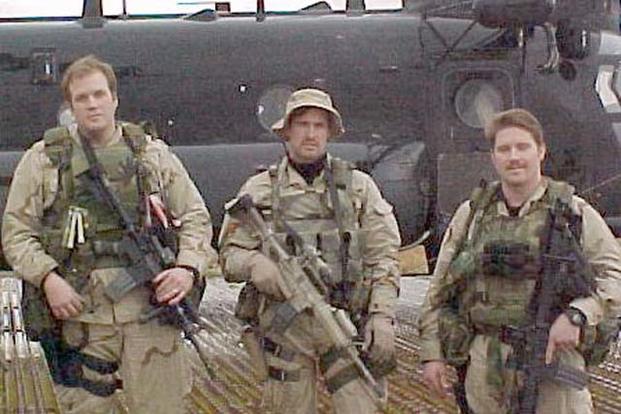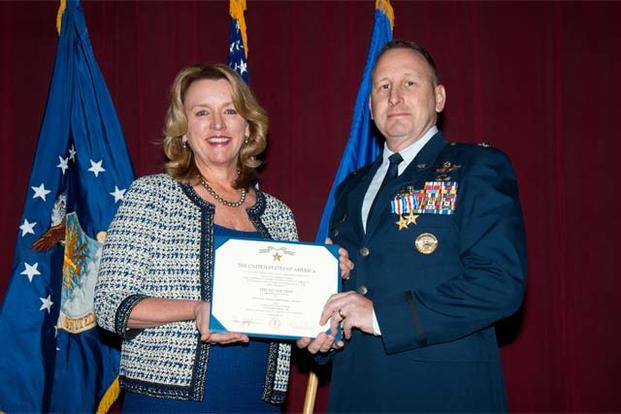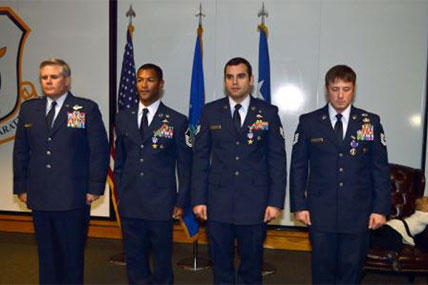The Air Force recently announced eight combat vets will get upgraded valor medals after a comprehensive review of awards from the wars in Iraq and Afghanistan.
The service reviewed 147 award nominations, including 12 Air Force Crosses and 135 Silver Stars, as part of the Defense Department's push to audit more than 1,100 post-9/11 valor citations to determine if they warrant a higher award.
Between them, the airmen and veterans were approved a total of nine medals, including the Air Force Cross, Silver Star and Distinguished Flying Cross with Valor.
Here's a brief look at the recipients and the actions for which they were recognized:
Keary Miller: Air Force Cross
Then-Tech. Sgt. Keary Miller was one of eight airmen awarded the Silver Star for the 17-hour-long "Battle of Roberts Ridge" in 2002 on the Takur Ghar mountain in Paktia Province, Afghanistan, according to the Military Times Hall of Valor database. Miller was the combat search and rescue team leader assigned to the 123rd Special Tactics Squadron, tasked with recovering two U.S. troops from the area. He arrived an hour after Tech. Sgt. John Chapman began coordinating a rescue effort for Navy SEAL Neil Roberts, who fell from an MH-47E Chinook helicopter as it was struck by enemy rocket-propelled grenades and machine-gun fire. Miller arrived with a helicopter of Army Rangers "to rescue a reconnaissance team that had come under fire while setting up an observation post as part of Operation Anaconda" attempting to clear the area of al-Qaida and Taliban forces, the Associated Press reported. Miller repeatedly faced heavy fire to assess wounded colleagues. He moved them to better cover and redistributed M203 grenades and 5.56mm rifle rounds from the deceased to coalition forces. He helped save 10 wounded troops and recover the bodies of seven others. Miller retired from the service as a master sergeant.
Christopher Baradat: Air Force Cross
Staff Sgt. Christopher Baradat, of the 21st Special Tactics Squadron at Pope Field, North Carolina, was attached to an Army Special Forces team as a combat controller in Afghanistan in 2013 when he was tasked to come to the aid of coalition forces closed in in the Sono Valley -- an area known for Taliban and al-Qaida militants, according to Military Times. On his third deployment, Baradat -- out in front of the fight -- engaged enemy positions by directing an A-10 Thunderbolt overheard to the targets. After seeking shelter amid heavy fire, Baradat emerged from his protected position, knowingly exposing himself to the enemy to "get the mission done," and called in additional A-10 and AC-130 reinforcements. "That was where I needed to be standing to communicate with the aircraft and to get the mission done," he said in an interview at the time. Even as his team was leaving the scene, he jumped onto a running board of a vehicle to better communicate with the aircraft above. His actions helped save more than 100 coalition members and contributed to killing roughly 50 hostile militants. Baradat separated from the service.
Christopher Barnett: Two Silver Stars
Then-Lt. Col. Barnett and his crew were flying their HH-60G Pave Hawk helicopter through firefights and sandstorms for a casualty evacuation in 2009 when he then received word "of a Special Forces convoy under attack by a large enemy force," near Kajaki, Afghanistan, according to his official award citation. After multiple shows of force, Barnett, the mission commander, "closed his aircraft to within 20 meters of the enemy, exposing themselves to harrowing fire to pinpoint the besieged team." Barnett and a second Pave Hawk remained flying overhead during multiple rocket-propelled grenade and machine-gun fire engagements, but closed in on the enemy during multiple attacks, forcing them to retreat. His actions contributed to saving the lives of more than 40 Green Berets and one Afghan National Army soldier, the Air Force said. On a separate mission a month later, Barnett, again the lead of two helicopters of the 34th Weapons Squadron, flew into a Taliban-run area near Marjah. The objective was to rescue "a severely wounded soldier during an intense four-day battle," his second citation reads. Barnett returned to the area for a second casualty rescue with zero visibility on approach and with "no close-air support" as the enemy began an overkill of ground fire. Barnett returned to the area a third time, and remained steadfast in protecting his wingman. As rocket-propelled grenades, mortars and machine guns rattled the fight zone, a mortar salvo detonated directly beneath Barnett's aircraft, "nearly knocking it out of the air," the citation said. But Barnett "remained in position to cover his wingman." Barnett received two Silver Star awards during a ceremony Thursday at Maxwell Air Force Base, Alabama. Then-Air Force Secretary Deborah Lee James traveled to Maxwell to present Barnett his awards in her last public ceremony before departing the Pentagon.
Kristopher Parker: Silver Star
Parker and his explosive ordnance disposal team were tasked with clearing caves thought to house ammunition caches for insurgent forces in Kandahar Province in 2014. Parker, a technical sergeant at the time, was assigned to the 466th Explosive Ordnance Disposal Flight and was supporting the Army's 82nd Airborne Division and Afghan Border Police during the mission. Upon initial descent, within 100 meters of the cave opening, the teams immediately saw gunfire, according to the Air Force's Portraits of Courage profile. Repeated airstrikes were called in to destroy a handful of IED caches. But before the team could make more progress, rocket-propelled grenades and a 20-pound IED were thrown at Parker and the other technicians, knocking Parker and some of his teammates back and resulting in concussions. Parker, in and out of consciousness, facilitated medical evacuation for their platoon leader, who sustained wounds during the 12-plus-hour battle that stemmed from the explosive mission. "Due largely in part to Parker's leadership and expertise, no American lives were lost that day," his profile says. Parker retired from the service as a master sergeant.
Gregory Thornton: Silver Star
Thornton was piloting his A-10 attack aircraft in Iraq in 2003 when he took fire from enemy tanks and armored infantry fighting vehicles. A captain at the time, he was supporting ground air controllers attached to a task force and armor battalion, according to a description provided by the Air Force. "With complete disregard for his personal safety, and while continually providing his element crucial defensive mutual support despite heavy anti-aircraft fire, Captain Thornton overcame extremely reduced in-flight visibility caused by a sandstorm, and attacked the battalion-sized armor element," the Air Force said. He flew through "a hailstorm" of enemy fire for more than half an hour, destroying multiple vehicles, and descended near the enemy lines at 3,000 feet using the A-10's 30mm Gatling gun. "Captain Thornton's superior flying skills and true attack pilot grit allowed the Task Force and Armor Battalion to successfully accomplish their objective of linking up with coalition forces completing the 360-degree encirclement of Baghdad," the Air Force said. Thornton retired from the service as a lieutenant colonel.
Alan Botine: Silver Star
Lt. Col. Alan Botine was the team lead for a group of Apache helicopters when he was informed a UH-60 helicopter had been shot down inside Iraqi territory controlled by hostile forces in 2003. Botine immediately initiated combat search and rescue protocol, "eventually controlling over 30 coalition aircraft in the rescue," according to the Air Force. Botine found himself in a contested area being tracked by five SA-2s, a Soviet SAM system, but flew low to identify vehicles nearing the crash site to prevent a friendly fire situation. Botine provided cover for the four crew members of the UH-60 into the night, a mission that needed six refuels and extended more than 10 hours. "As the night progressed, rapidly deteriorating weather eventually forced flight below [5,000] feet in the middle of heavy anti-aircraft fire to maintain coverage of the four survivors," the Air Force said. As time stretched thin, Botine lead the Apache coalition to find the crash site, shining "all external lights" on three separate occasions. He "ensured the fellow Americans were provided protection while he repeatedly exposed himself to hostile fire." Botine retired from the service as a lieutenant colonel.
David Kennedy: Distinguished Flying Cross with Valor (posthumous)
Col. David Kennedy, an A-10 pilot, in 2003 was called to a firefight in downtown Baghdad, Iraq, where U.S. Marines were pinned down by a heavy attacks from rocket-propelled grenades and machine-gun fire. "Colonel Kennedy was given an urgent directive by the Marine battlefield controller to provide emergency close-air support for the hard-pressed Marines in the city, one of whom had been killed and 42 wounded," the Air Force said. The Marine ground controller informed Kennedy of the intensifying situation, as the Marines were unable to evacuate the wounded. Kennedy "volunteered" to go into the heart of the intense ground fire and "with total disregard for his personal safety, rolled in multiple times amid the enemy anti-aircraft and small arms fire to prosecute attacks on the enemy" with his 30mm cannon. "Through the selfless act of Colonel Kennedy, [the show of force] broke the back of the enemy and saved the lives of many Marines," the Air Force said. Kennedy had retired from service before he passed away, according to Air Force spokesman Zachary Anderson.
James Holder: Distinguished Flying Cross with Valor
Lt. Col. James Holder was in the middle of a rescue attempt "for a critically ill Special Forces Soldier in a classified location in 2001," when a MH-53M helicopter crashed behind enemy lines, according to the service. While the Air Force did not identify the type of aircraft Holder and his team were operating in their description to Military.com, Holder, then a lieutenant (1st or 2nd rank not specified), "and his crew braved enemy fire, high altitudes, extremely mountainous terrain, and extreme weather conditions to successfully rescue the team members and crew aboard the helicopter," the service said. Holder faced extreme weather conditions with limited visibility during a whiteout over the crash site, but managed to carefully land within a "very narrow canyon" with only night-vision goggles to guide his line of sight. Holder, who successfully rescued the downed airmen, then quickly realized that his aircraft didn't have the power boost required for takeoff. He instead manipulated the flight controls and aircraft power "to gradually build up the rotor speed as they slowly lifted away from the dangerous terrain below," the service said. Holder is currently assigned to Special Operations Command at MacDill Air Force Base, Florida, according to the Air Force Personnel Center.
-- Do you have stories about these airmen? Send your information to reporter Oriana Pawlyk at oriana.pawlyk@military.com. Your comments may be included for an upcoming feature.
-- Oriana Pawlyk can be reached at oriana.pawlyk@military.com. Follow her on Twitter at @Oriana0214.
































